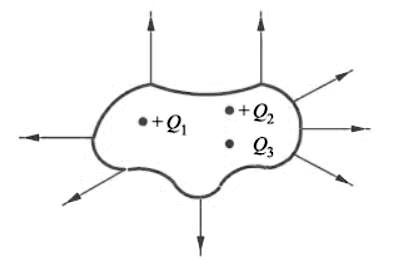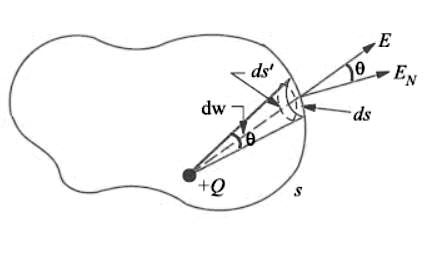Gauss Law
Consider a point charge Q lying at the centre of a sphere of radius r which surrounds it completely [Figure given below]. The total number of tubes of flux originating from the charge is Q (but number of lines of force is Q/ε0) and are normal to the surface of the sphere. The electric field E which equals Q/4 π ε0 r2 is also normal to the surface. As said earlier, total number of lines of force passing perpendicularly through the whole surface of the sphere is


Now, suppose we draw another sphere surrounding the charge [Figure given above] but whose centre does not lie at the charge but elsewhere. In this case also, the number of tubes of flux emanating from the charge is Q and lines of force is Q.ε0 though they are not normal to the surface. These can, however, be split up into cos θ components and sin θ components. If we add up sin θ components all over the surface, they will be equal to zero . But if add up cos θ components over the whole surface of the sphere, the normal flux will again come out to be Q (or lines of force will come out to be Q/ε0).
Hence, it shows that irrespective of where the charge Q is placed within a closed surface completely surrounding it, the total normal flux is Q and the total number of lines of force passing out normally is Q/ε0.
In fact, as shown in Figure given below, if there are placed charges of value Q1, Q2, − Q3 inside a closed surface, the total i.e. net charge enclosed by the surface is (Q1 + Q2 − Q3)/ε0 through the closed surface.

This is the meaning of Gauss’s law which may be stated thus : the surface integral of the normal component of the electric intensity E over a closed surface is equal to 1/ε0 times the total charge inside it.
Mathematically, ![]() (where the circle on the integral sign indicates that the surface of integration is a closed surface).
(where the circle on the integral sign indicates that the surface of integration is a closed surface).

when E and D are not normal to the surface but make an angle θ with the normal (perpendicular) to the surface as shown in Figure given below.

Proof. In Figure given below, let a surface S completely surround a quantity of electricity or charge Q. Consider a small surface area ds subtending a small solid angle dω at point charge Q. The field intensity at ds is

where d is the distance between Q and ds.
In vector notation, ![]() (where ρ is the volume density of charge in the volume enclosed by closed surface S).
(where ρ is the volume density of charge in the volume enclosed by closed surface S).
Thus ![]() is the vector statement of Gauss Law* and its alternative statement is ∇ D = ρ
is the vector statement of Gauss Law* and its alternative statement is ∇ D = ρ
The normal component of the intensity En = E cos θ
∴ No. of lines of force passing normally through the area ds is
= En.ds = E ds cos θ = E. ds in vector notation

Total number of lines of force over the whole surface

where sign ![]() denotes integration around the whole of the closed surface i.e. surface integral. If the surface passes through a material medium, then the above law can be generalized to include the following :
denotes integration around the whole of the closed surface i.e. surface integral. If the surface passes through a material medium, then the above law can be generalized to include the following :
the surface integral of the normal component of D over a closed surface equals the free charge enclosed by the surface.
![]()
Hence, the normal electric flux from area ds is

which proves the statement made above.
Hence, we may state Gauss’s law in two slightly different ways.
![]()
and
![]()
Read article – Units of Resistivity
Visit NCERTplanet.com for NCERT solutions and Textbook downloads




